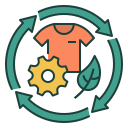
Emerging Innovations in Sustainable Fashion
The world of fashion is undergoing a transformative shift as sustainability becomes central to the industry’s future. Driven by consumer demand, environmental concerns, and groundbreaking technologies, fashion brands and designers are reimagining how clothing is designed, produced, circulated, and marketed. Emerging innovations are pushing boundaries, responding not only to ecological imperatives but also to new possibilities for creativity and business models. This page explores the most influential advancements reshaping sustainable fashion, from regenerative materials to digital innovation, decentralized supply chains, and circular design. Discover how these changes are redefining an industry long known for waste and excess into one that holds the potential for positive social and environmental impact.
Revolutionary Sustainable Materials
Bio-based Fibers Redefining Textiles
Recycling Technologies for Circular Materials
Lab-grown and Engineered Fabrics

Circular Economy and Clothing Life Extension
Rental Platforms and Sharing Models
Upcycling and Repair Initiatives
Resale Marketplaces and Secondhand Growth

Regenerative Agriculture and Traceable Sourcing
Regenerative Farming for Fiber Crops
Blockchain Traceability and Supply Chain Transparency
Ethical Certifications and Third-Party Audits

